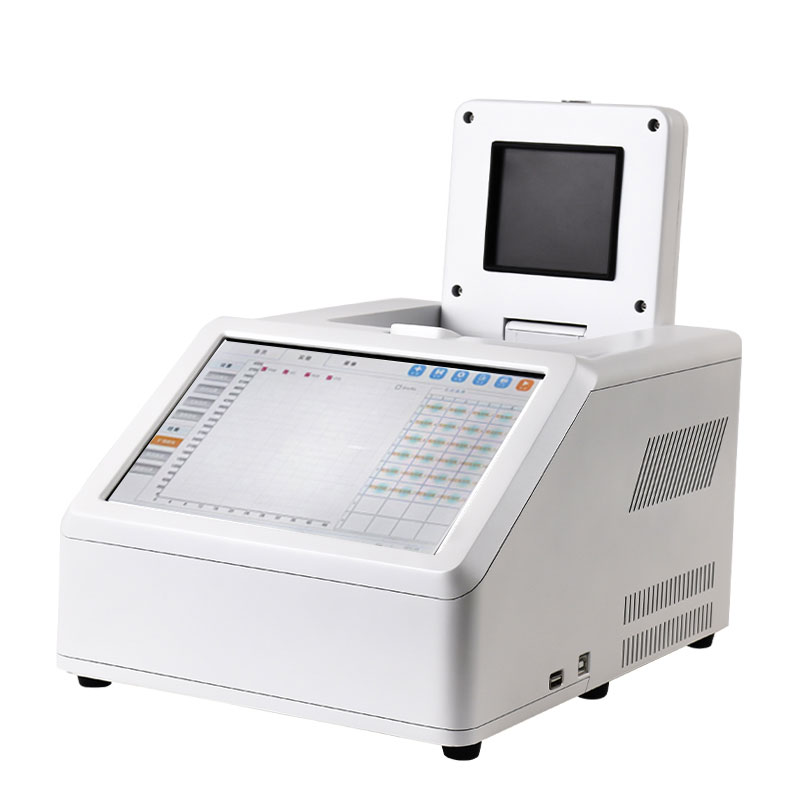Tianyi Sensor IOT Technology Co., Ltd
Sales Manager:Ms. Emily Wang
Cel,Whatsapp,Wechat:+86 15898932201
Email:info@fengtutec.com
Add:No. 155 Optoelectronic Industry Accelerator, Gaoxin District, Weifang, Shandong, China

Sales Manager:Ms. Emily Wang
Cel,Whatsapp,Wechat:+86 15898932201
Email:info@fengtutec.com
Add:No. 155 Optoelectronic Industry Accelerator, Gaoxin District, Weifang, Shandong, China

Model:FT-CW16H
Brand:tianyi
fluorescence quantitative PCR instrument basic structure
Fluorescence quantitative PCR instrument is a rapid real-time fluorescence PCR detection instrument that provides accurate nucleic acid quantification through real-time monitoring.fluorescence quantitative PCR instrument is an instrument that detects reactions in real time, mainly composed of a gene amplification thermal circulation system, a fluorescence real-time detection system, a microcircuit control system, a computer and application software. Two of the core functional modules are: the thermal circulation system and the fluorescence real-time detection system. Among them, the working principle of the gene amplification thermal cycle system is basically the same as that of the traditional gene amplification instrument, and the thermal cycle process is completed by semiconductor heating and refrigeration. The fluorescence detection system mainly consists of fluorescence excitation components, optical signal transmission components, fluorescence detection components, and control systems.
fluorescence quantitative PCR instrument technical indicators
The "///" symbol indicates that the national standard currently does not define this indicator or mandatory requirement.
| Metric Name | CW16H | CW32H | CW48H | |
| Appearance | ||||
| External dimensions | 235mm*385mm*175mm (width*deep*height) | |||
| weight | 5.6kg | 5.7kg | 5.8Kg | |
| Electrical parameters | ~220V/50Hz, 255W | |||
| Data interface | USB 2.0 *2 (two on the right) | |||
| Environment parameters | ||||
| Running conditions | Temperature: 10-30℃, humidity: 20%~80% | |||
| Transportation and storage conditions | Temperature: -20~55℃, humidity: 20%~80% | |||
| Altitude | <2500 meters | |||
| Noise level | A weight, <60dB | |||
| Sample parameters | ||||
| Sample capacity | 16*0.2mL | 32*0.2mL | 48*0.2mL | |
| Test tube type | Single tube, eight-line test tube | |||
| Sample volume | 15-100uL | |||
| Temperature characteristics | ||||
| Heating/cooling method | Semiconductor heating/refrigeration | |||
| Temperature range | 4℃-99℃ | |||
| Maximum heating rate | ≥3.5℃/s | |||
| Average heating rate | ≥2.5℃/s | |||
| Maximum cooling rate | ≥3.5℃/s | |||
| Average cooling rate | ≥2.5℃/s | |||
| Temperature control accuracy | ≤±0.01℃ | |||
| Temperature accuracy | ≤±0.1℃ | |||
| Temperature uniformity | ≤±0.3℃ | |||
| Optical properties | ||||
| Number of fluorescence detection channels | 4 channels | |||
| Light emitting devices | High brightness LED | |||
| Lighting devices | High sensitivity, high signal-to-noise ratio photodiode | |||
| Adapt probe or dye | First channel: 470/520 FAM, SYBR Green | |||
| Second channel: 530/570 HEX, JOE, VIC | ||||
| Third channel: 580/610 ROX, CY3.5, Texas-Red | ||||
| Channel 4: 630/670 CY5 | ||||
| Detection sensitivity | 1 copy | |||
| Linear detection range | 100~1010 copies | |||
| Linear correlation coefficient | ≥0.999 | |||
| Channel cross-talk | No cross-talk | |||
| Detect repeatability | ≤1.0% | |||
fluorescence quantitative PCR instrument main application fields
Foodborne pathogenic bacteria detection
Food Safety
Animal and plant origin detection
Plant Science and Agricultural Biotechnology
Gene mutations and polymorphisms
Animal Blight
Basic scientific research
Water monitoring
Pathogen nucleic acid detection
Genetically modified test
Animal epidemic monitoring
Food hygiene quarantine
Customs import and export quarantine
Please note that this is a basic meteorological instrument capable of monitoring only wind speed, wind direction, air temperature and humidity, and air pressure.When equipped with sensors for dust concentration, harmful gases (such as sulfur dioxide, nitrogen oxides), PM2.5, PM10, etc., it becomes a...
The Nine - element PV Weather Station is a meteorological monitoring device specifically designed for photovoltaic power generation systems.Distributed photovoltaic power generation is mainly for self - consumption by users on the user side, and the surplus electricity is fed into the grid. The norm...
Entering the high - standard farmland demonstration area, 25 newly installed Solar insecticidal lamps are neatly arranged in the fields. These devices consist of silver lamp poles, black solar panels, and green lamp housings. They absorb solar energy and store electricity during the day, and at nigh...
The buoy-type online water quality monitoring system is a modern water body monitoring method. As an automated device for long-term and real-time monitoring of water quality, it is widely used in environmental monitoring of various water areas such as rivers, lakes, oceans, reservoirs, and aquacultu...